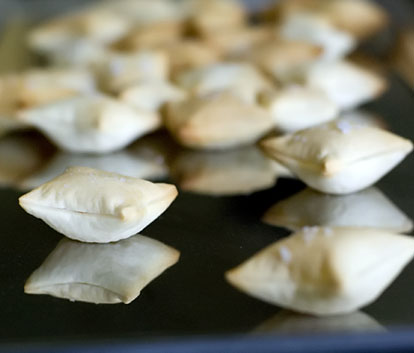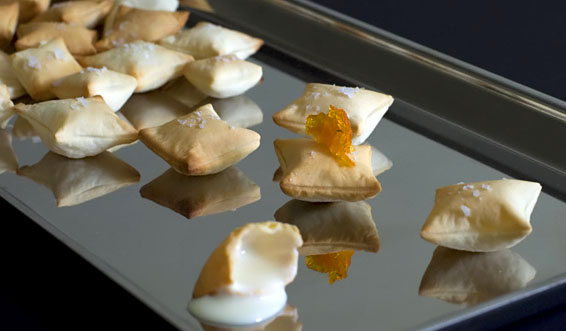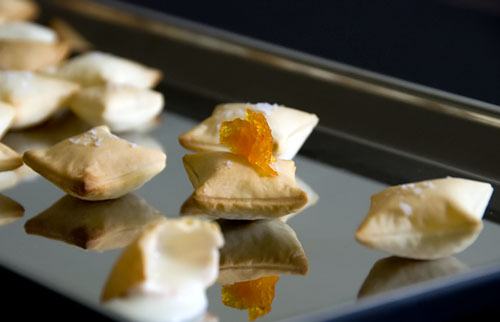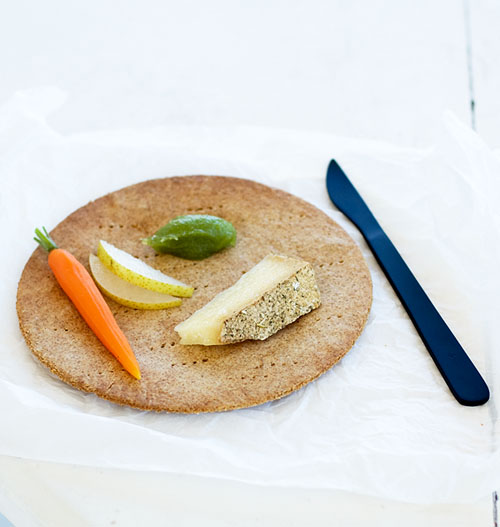November 18, 2008 at 10:40 pm

I probably should be telling you about how good these crackers were. How easy they were to make, and how thrilling it was to pull them out of the oven, puffed up like little pillows for chipmunks. How, after they were assembled, you could bite into one and warm cheese would flood instantly into your mouth, caressing every single tastebud. Yes, every tastebud. Even the ones that usually only perk up in the presence of panfried brussel sprouts with chestnuts, or brownie crusts. Personally speaking, that is.

I should be telling you that these crackers, with their bellies full of cheese, were equally good topped with homemade carrot and orange marmalade. The marmalade, being eye-catchingly orange in colour, textured and vibrant in flavour, was one of the most simple but astonishingly good things I had made of late.

I should be telling you about these crackers, but what stuck in my mind most was the bit of effort it took to talk B into buying a syringe from the chemist for me, on his way home from work. How reluctant he was to do it at first, because, I mean, a syringe? What would people think!
(Tell them it’s for injecting cheese into crackers, I told him. I’d rather say it’s for drugs, he replied dryly. At least they won’t look at me as strangely.)
After a bit more cajoling, he finally acquiesced, but oh, how embarrassed he was when the chemist gave him a disapproving look, saying, “We don’t do that sort of thing here”, when he asked for a needle that would fit the syringe.
I could be telling you all these things, but I think all you really need to know is, yes, thank goodness, there is a recipe :
Cheese in Cracker :
(from Grant Achatz’s Alinea)
Cracker Dough :
215g warm water
13g fresh yeast
4g sugar
470g plain flour
4g kosher salt
55g melted butter
kosher salt
In bowl of stand mixer, stir together water, yeast, and sugar. Let stand for 5 minutes to proof yeast. Add flour, 4g salt, and butter. Attach bowl to mixer, fit mixer with dough hook, and beat on low speed for about 6 minutes, or until dough comes together and forms firm ball. Remove bowl from mixer, cover, and let dough rise in warm place for 25 minutes. Then refrigerate bowl overnight.
The following day, transfer dough to warm place. Divide dough into 4 equal pieces. Line sheet tray with parchment. Preheat oven to 230’C. Using rolling pin or pasta machine, roll out 1 piece of dough about 2mm thick. Save remaining dough for another use. Cut dough sheet into 8 2.5cm squares. Transfer squares to prepared sheet tray. Season squares liberally with salt.
Bake for 6 minutes. Each cracker will puff in center and turn golden brown. Let cool on wire rack to room temperature. Using needle of syringe, punch 1 small hole in each cracker. Reserve in airtight container.
Cheddar Cheese Sauce :
150g aged Wisconsin Cheddar cheese
150g whole milk
6g kosher salt
4g sugar
Grate cheese on large holes of box grater. Transfer cheese to blender. In small saucepan, bring milk to a simmer. Remove from heat and pour into blender. Add salt and sugar and blend on high speed until cheese has melted and liquid is very smooth. Pass through chinois into small container. Cover and reserve in warm place until ready to fill crackers.
To assemble and serve : Fill syringe with 30cc of cheese sauce. Using hole made with syringe needle, inject sauce into cracker. Do not overfill or cracker will burst.
[Notes : For the cheese sauce, I used what I had – a mixture of aged Cheddar and Parmesan. In the absence of a syringe needle, a sharp skewer works well to create a neat hole in the cracker large enough for the nozzle to transfer the cheese sauce. The sauce does not leak out once cracker is filled, but the cracker will start to soften over time.]
Carrot and Orange Marmalade :
(by Dan Hunter; from V.EAT Sept/Oct 2008)
850g carrots, peeled, coarsely grated
Juice and finely grated zest of 2 limes
Juice and finely grated zest of 2 lemons
200ml orange juice
820g caster sugar
Combine carrots, 60ml lime juice, 160ml lemon juice, lime and lemon zests and orange juice in a bowl, cover with plastic wrap and refrigerate overnight.
The following day, transfer the mixture to a heavy-based saucepan, add sugar and cook over medium heat for 1 hour or until syrup is reduced and sticky. Transfer to an airtight container and cool. Marmalade will keep, refrigerated, for up to 2 months. Makes 2 1/2 cups.





